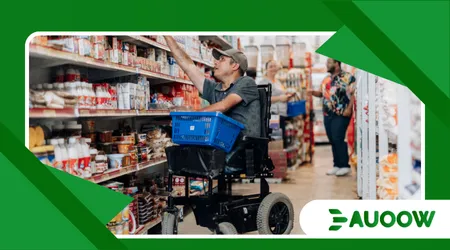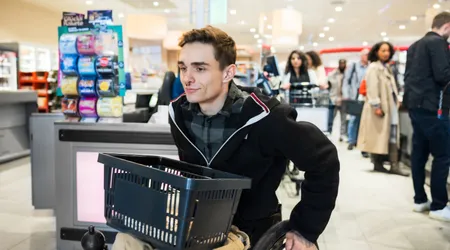How to Plan Grocery Trips with a Wheelchair: A Realistic Guide

For many, grocery shopping is a mundane chore, but for wheelchair users, it transforms into a logistical challenge requiring precision planning and strategic execution.
This guide, How to Plan Grocery Trips with a Wheelchair, focuses on actionable, real-world strategies to maximize independence and minimize stress.
Navigating crowded aisles, reaching high shelves, and handling unwieldy carts are all physical barriers that require smart solutions.
Successfully managing this essential task fundamentally impacts daily autonomy and nutritional freedom. We delve into preparation, timing, and equipment modifications.
Learning How to Plan Grocery Trips with a Wheelchair is about converting potential frustration into a routine, streamlined experience that respects your time and energy.
Why Is Pre-Trip Planning the Most Critical Step?
The success of any shopping trip, especially when mobility is a factor, hinges entirely on preparation before leaving home.
How Can I Maximize My Time by Organizing My Shopping List?
The most effective strategy is organizing your list by store layout. Don’t just list items; list them in the order you’ll encounter them, grouping produce, dairy, frozen items, and shelf goods.
This technique prevents unnecessary backtracking, saving significant time and energy. Going through an aisle once is always better than circling back repeatedly through congested spaces.
Knowing the store map intimately transforms you from a passive shopper into an efficient navigator. This detail-oriented approach is central to knowing How to Plan Grocery Trips with a Wheelchair.
++ How AR Navigation Apps Are Helping Disabled Travelers Explore Cities
What is the Best Time of Day to Shop for Accessibility?
Timing is paramount. Stores are significantly less crowded during weekday mornings, especially shortly after opening, and late evenings. Avoid peak hours like Saturday afternoons or weekday rush hour after 5 PM.
Lower foot traffic means easier maneuvering, less confrontation with other shoppers, and quicker access to accessible checkouts. A quiet environment also reduces sensory overload, making the trip far more pleasant.
The reduced crowd size often correlates with better staff availability. They are more likely to be free to provide immediate assistance if needed.

What Tools and Equipment Should I Use for Cart Management?
Managing a cart while operating a wheelchair is arguably the biggest logistical hurdle in the supermarket environment.
What Are the Best Cart Solutions for Wheelchair Users?
While many large supermarkets now offer dedicated wheelchair-friendly carts, their availability is inconsistent, making personal solutions essential.
Also read: Daily Accessibility: What is good contrast ratio WCAG
Using Wheelchair Add-Ons for Hands-Free Shopping
Many companies now manufacture specific cart add-ons that attach directly to the front or side of a manual or power wheelchair. These secure, smaller baskets allow for genuine hands-free propulsion.
These dedicated baskets eliminate the need to push a massive, separate cart, which is mechanically difficult and ergonomically straining. This is a game-changer when learning How to Plan Grocery Trips with a Wheelchair.
These innovative attachments provide independent movement, which is the ultimate goal. They represent a significant step up from balancing a small basket on one’s lap.
Read more: Accessibility Myths Debunked: Separating Fact from Fiction
The Utility of Reach Extenders and Grabbers
A simple, lightweight reacher or grabber tool is indispensable. It allows users to safely access items on high shelves or those located deep within display cases.
Using this tool reduces the need to constantly ask staff for help, fostering greater self-reliance during the shopping process. Look for models that are easily collapsible and stowable on the chair.
Carrying the right tools means you are equipped for any unexpected obstacle. It transforms the shopping trip from a high-stakes scavenger hunt into a manageable routine.
How Can I Ensure My Chosen Store is Truly Accessible?
Just because a store complies with the bare minimum of accessibility standards does not mean it is truly easy to navigate.
Beyond the Ramp: What Makes a Supermarket Truly Wheelchair-Friendly?
True accessibility goes beyond the entrance; it includes lighting, aisle width, and checkout design.
Assessing Aisle Width and Product Placement
Narrow aisles, often cluttered with promotional displays or stock pallets, are primary barriers. Before committing to a store, perform a test run during a non-peak hour to check the maneuverability.
Also, observe product placement. Are high-demand items consistently placed on the highest or lowest shelves? Look for stores that show a conscious effort to place staple items within reach (30-48 inches from the floor).
Analogy: Shopping in an inaccessible store is like trying to solve a maze where the walls are constantly moving and the floor is uneven. A truly accessible store offers a clear, predictable, and uncluttered path.
Why Accessible Checkouts and Parking Matter
The parking situation is the first and last point of friction. Dedicated access aisles must be clear, well-maintained, and close to an automatic door.
At the end of the trip, the checkout counter must be wide enough and high enough for the transaction to occur comfortably. Do they have a space specifically reserved for wheelchair-users to place items on the belt? This detail is crucial for fully mastering How to Plan Grocery Trips with a Wheelchair.
A study by the Business Disability Forum in 2024 revealed that 43% of disabled shoppers reported abandoning a purchase in-store due to physical barriers, proving the necessity of these checks.
What Role Does Staff Assistance and Online Shopping Play?
Independent shopping is the goal, but knowing when and how to leverage staff assistance and technology provides essential backup.
How Should I Strategically Request In-Store Assistance?
Staff are legally and ethically obliged to assist, but the approach matters. Locate a staff member near the service desk or management first, rather than flagging down a busy stocker.
Clearly state what you need: “Could you please help me reach the top-shelf almond butter, and the three bags of frozen peas?” Being specific saves time for both parties.
Building a rapport with staff at your preferred time and location can lead to preemptive help. Consistent communication makes them aware of your routine needs.
When Is Online Grocery Shopping the Better Option?
For bulk purchases, heavy items (pet food, bottled water), or non-perishables, online ordering with home delivery is often the most efficient choice. This significantly reduces physical exertion and travel fatigue.
The rise of ‘Click and Collect’ services also offers a fantastic compromise: you shop online, and staff load the items directly into your car upon arrival, eliminating the in-store navigation challenge completely.
Example 1 (Click and Collect): Instead of spending 90 minutes navigating the store, you spend 15 minutes online and 5 minutes at the curb while an employee loads the $200 order into your trunk. This maximizes time and energy savings.
Comparison of Grocery Shopping Methods for Wheelchair Users (2025)
| Method | Primary Benefits | Primary Drawbacks | Best for… |
| In-Store (Manual) | Full choice/selection control; immediate purchase. | Physical exertion; difficulty reaching; crowded aisles. | Small, quick trips; fresh produce selection. |
| Click & Collect (Online Order/Store Pickup) | Zero in-store navigation; staff loads heavy items. | Requires timely parking space; potential for product substitution errors. | Large, scheduled weekly hauls; heavy pantry staples. |
| Home Delivery (Online Order/Delivery) | Maximum energy savings; ultimate convenience. | Delivery fees; reliance on delivery slot availability; quality control issues (produce). | Bulk, non-perishable goods; times of high fatigue. |
Conclusion: Achieving Independent and Stress-Free Shopping
The true art of How to Plan Grocery Trips with a Wheelchair lies in strategic preparation, leveraging technology, and smart store selection.
By organizing your list by store layout, timing your visits to avoid crowds, and utilizing accessible carts or personal add-ons, you take control of the experience.
The aim is to eliminate moments of frustration and replace them with predictable efficiency, turning a challenging chore into a manageable routine. Achieving true independence in daily tasks like this is invaluable.
Which of these preparation steps do you find most helpful in your own routine? Share your best accessibility hacks for aisle navigation in the comments!
Frequently Asked Questions (FAQ)
Q: Are the store’s motorized carts always available and accessible?
A: Not always. Motorized carts are often in high demand, may be out of charge, or may not be the most comfortable for long-term users. It’s wise to have a backup plan (like the wheelchair add-on).
Q: Should I call the store ahead of time to ask for help?
A: Yes, especially for a major, infrequent trip. Calling the customer service desk to ask about their quietest time and to request a staff member to be available for retrieving high-shelf items can drastically improve the experience.
Q: What if a store’s aisles are too narrow to turn around in?
A: If a store consistently has aisles too narrow for safe and comfortable maneuvering, your best strategy is to find a different, more modern, or consciously accessible supermarket. Your safety and comfort are the priority when you plan grocery trips with a wheelchair.
